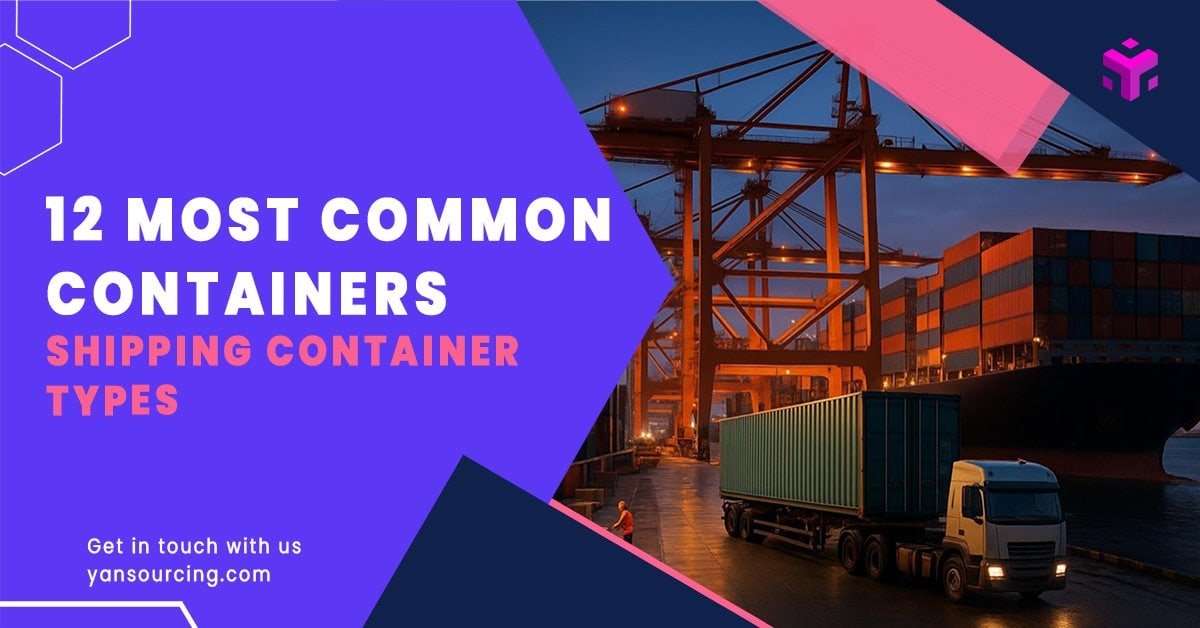
Choosing the right container type isn’t just a specs exercise—it dictates your landed cost, risk profile, and schedule reliability from China to your destination.
If you’re an e-commerce brand (especially Amazon FBA apparel), the difference between 40GP and 40HC can mean fewer LCLs, fewer touchpoints, and fewer surprises at the port.
This guide breaks down the 12 most common container types with practical, China-to-West execution tips: cut-off timing, VGM, factory loading pitfalls, and when to go FCL vs LCL.
Methodology and how to use this guide
- We focus on widely available, ISO-compatible equipment that carriers and leasing companies routinely operate. Category definitions align to industry practice and the DCSA overview in the Shipping Container Types: A Guide (DCSA, accessed 2025).
- Dimensions, door apertures, and payloads vary by manufacturer and series. For typical internal/external dimensions, we reference the consolidated dimension overviews on DSV’s container dimensions pages (DSV, accessed 2025). Always confirm with the booking carrier at time of quote.
Planning support: If you need help matching equipment to SKU mix, first-load plans, or FBA compliance, our China-side team can map it with you—see Yansourcing for one-stop sourcing, inspection, loading supervision, and shipping coordination.
Anchor use case we’ll reference throughout: An Amazon FBA seller launching a private‑label apparel line from China to the US/EU, shipping regular replenishments with mixed sizes and seasonal SKUs.
General dry cargo (the everyday workhorses)
1) 20GP — 20-foot standard dry
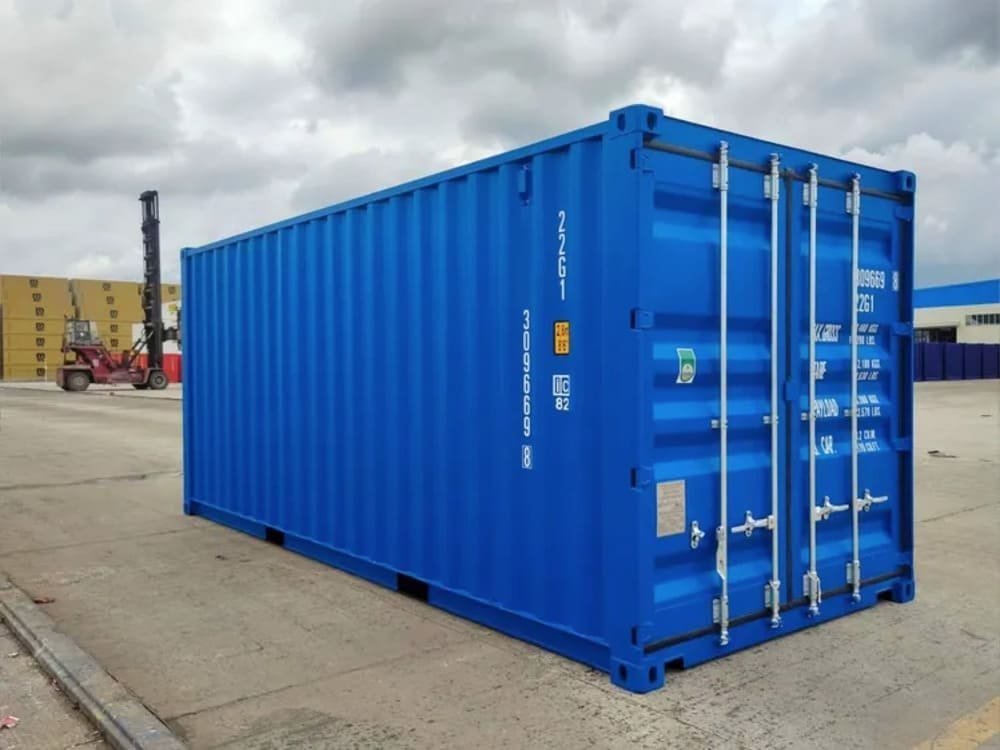
Positioning: The densest pound-for-pound option; great when weight, not volume, is your constraint.
Typical size/capacity (varies by operator):
- Internal around 5.90 m L × 2.35 m W × 2.39 m H; door opening roughly 2.34 m W × ~2.28 m H.
- External 6.06 m × 2.44 m × 2.59 m. Tare typically ~2.2–2.36 t; common max gross up to ~24–28.2 t.
Best for:
- Dense commodities (hardware, metal parts, building materials)
- Apparel when you’re early-stage and consolidating dense cartons
Not for:
- Over-height pallets that won’t clear the door or roof ribs
- Very voluminous light cargo that will cube out first
China-to-West execution tip:
- Watch axle load limits on the dray in China; avoid heavy concentration at one end. Submit SOLAS VGM ahead of CY cut-off so you’re load-ready.
Reference anchor: See DSV’s typical dimension ranges cited in the Methodology (accessed 2025).
2) 40GP — 40-foot standard dry
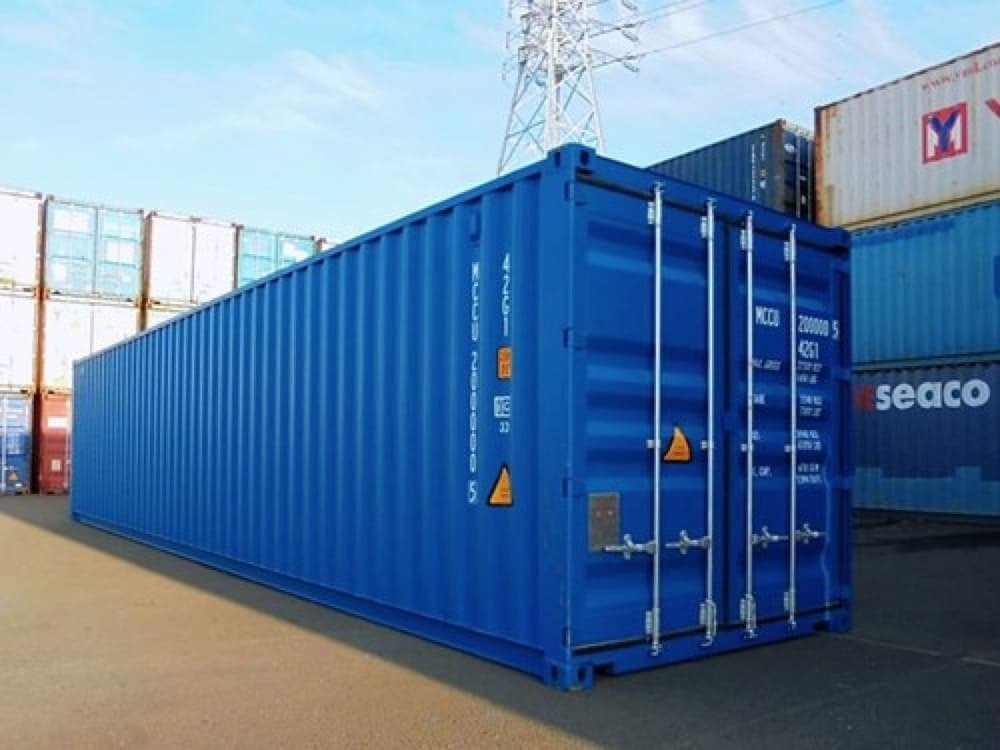
Positioning: The step-up in floor space from 20GP, common for apparel when pallet height is moderate.
Typical size/capacity (varies):
- Internal about 12.03 m L × 2.35 m W × 2.39 m H; door ~2.34 m W × ~2.28 m H.
- Tare ~3.8–4.3 t; common max gross ~30.5–32.5 t.
Best for:
- Mixed-SKU shipments where volume is the main constraint
- Early FCL transitions from repeated LCLs
Not for:
- Tall pallets that need more headroom (consider 40HC)
China-to-West execution tip:
- For Amazon-bound pallets, plan carton sizes so the built pallet height fits the door aperture; check FBA pallet caps before you commit to a 40GP.
Reference anchor: Dimension ranges per DSV summary (accessed 2025).
Mini playbook: Why many FBA apparel brands favor 40HC over 40GP?
- Apparel is light/voluminous. With a 40HC, you can often stack pallets taller (within safe and compliant limits), reducing total shipments per season.
- Fewer sailings and touchpoints usually mean fewer opportunities for delay or damage.
Extra volume (height/length advantages)
3) 40HC / 40HQ — 40-foot high cube

Positioning: Typically ~13% more internal volume than 40GP thanks to the extra height; an apparel favorite.
Typical size/capacity (varies):
- Internal roughly 12.03 m L × 2.35 m W × ~2.70 m H; door height ~2.58–2.60 m.
- Volume commonly around ~76 m³ vs ~67 m³ in a 40GP.
Best for:
- Apparel cartons on taller pallets; other light/voluminous SKUs
- FBA replenishments when you’re trying to reduce shipment frequency
Not for:
- Extremely dense cargo where payload is the bottleneck
China-to-West execution tip:
- Keep 6–8 cm clearance under the roof ribs when planning pallet height; verify the door height, not just internal ceiling, for FBA pallets.
Evidence: Hapag-Lloyd’s equipment page for the 40′ Standard High Cube outlines the added internal height and door aperture ranges in its fleet specs (Hapag-Lloyd — 40′ Standard High Cube, accessed 2025).
4) 45HC — 45-foot high cube
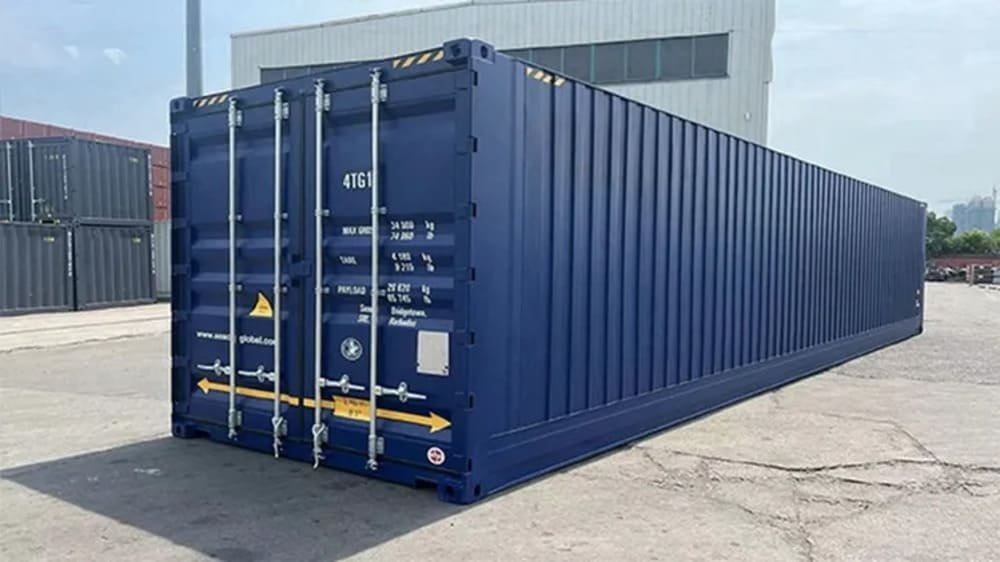
Positioning: Extended length plus HC height—for lanes that support it, you gain meaningful floor area and volume.
Typical size/capacity (varies):
- Internal around 13.55 m L × 2.35 m W × ~2.70 m H.
Best for:
- High-volume, light cargo with stable China–EU or China–UK routings that regularly accept 45HC
Not for:
- Routes with limited 45HC equipment or terminal restrictions; complex transshipments with acceptance constraints
China-to-West execution tip:
- Confirm 45HC availability and any equipment or imbalance surcharges before you bake it into your S&OP calendar.
Evidence: Triton outlines availability and specs for 45’ pallet-wide high cube units, which highlights the equipment’s role in European lanes (Triton — 45ft Pallet-Wide High Cube Containers, accessed 2025).
Access and loading flexibility
5) Open Top (20’ / 40’)

Positioning: Crane-in from above via a removable roof/tarpaulin—ideal when cargo won’t fit through the doors or needs vertical loading.
Typical size/capacity (varies):
- Internal lengths match 20’/40’ standards; inner height typically similar to standard dry of the same length, with bows/tarpaulin instead of fixed roof.
Best for:
- Machinery, timber, oversized pieces loaded vertically
Not for:
- Goods needing the impact resistance of a rigid steel roof (consider Hard Top instead)
China-to-West execution tip:
- Plan for weatherproofing under tarpaulin and ensure customs sealing is compliant at the origin terminal.
Evidence: DSV provides typical open-top dimensions and handling notes across sizes (DSV — Open Top Container, accessed 2025).
6) Hard Top (20’ / 40’ / 40HC)

Positioning: Steel removable roof for top loading with more protection than a tarpaulin; useful when crane-access and roof rigidity both matter.
Typical size/capacity (varies):
- Internal heights are close to equivalent dry containers, with removable steel roof sections.
Best for:
- Marble, glass, precision machinery—cargo benefiting from top loading plus rigid roof protection
Not for:
- Temperature-sensitive goods that need active control (reefer), or cargo that easily fits via doors (simpler options may be cheaper)
China-to-West execution tip:
- Check handling at the origin terminal—roof removal/installation may require specific equipment and time windows.
Evidence: Hardtop is a standard variant within carrier fleets, grouped under special equipment types (see Hapag-Lloyd’s container type groups overview, accessed 2025) (Hapag-Lloyd — Container type groups).
7) Side-door / Double-door (Tunnel)
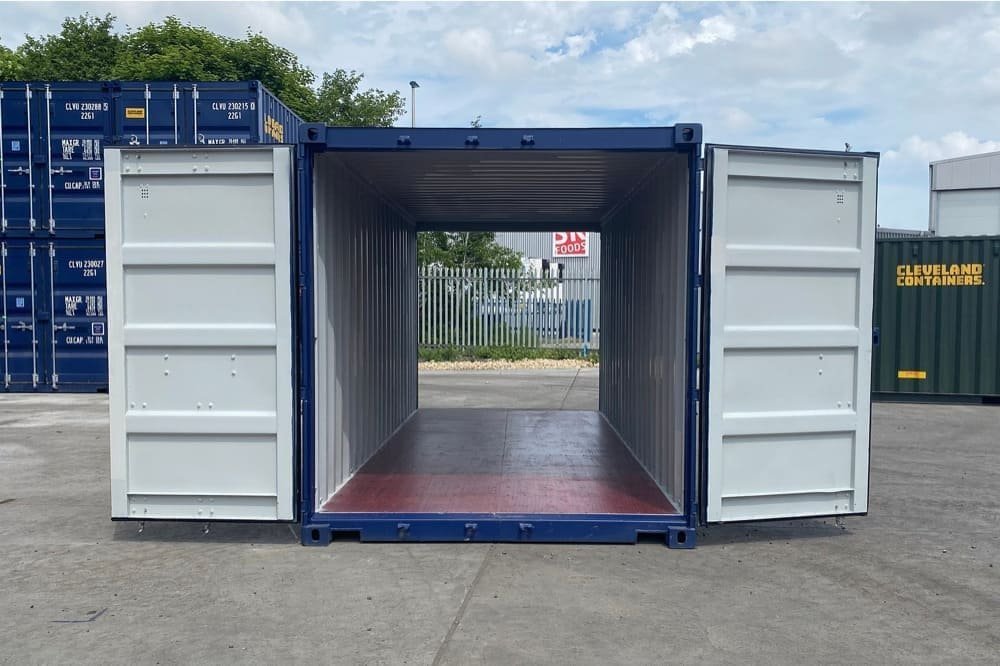
Positioning: Additional access points—either doors on the side or at both ends—speed up loading/unloading and help with long items.
Typical size/capacity (varies):
- Similar internal dimensions to standard/HC counterparts, with modified door configuration.
Best for:
- Palletized goods where cross-access is valuable; long items that benefit from two-door loading
Not for:
- Loads where the strongest wall rigidity is required—additional doors can reduce wall continuity
China-to-West execution tip:
- Confirm availability on your specific origin port; not all depots stock side-door or tunnel units for every sailing.
Reference anchor: Configuration notes align with carrier/leasing specs; see the Hapag-Lloyd type groups link above for families of special equipment (accessed 2025).
Heavy and out-of-gauge
8) Flat Rack (20’ / 40’)
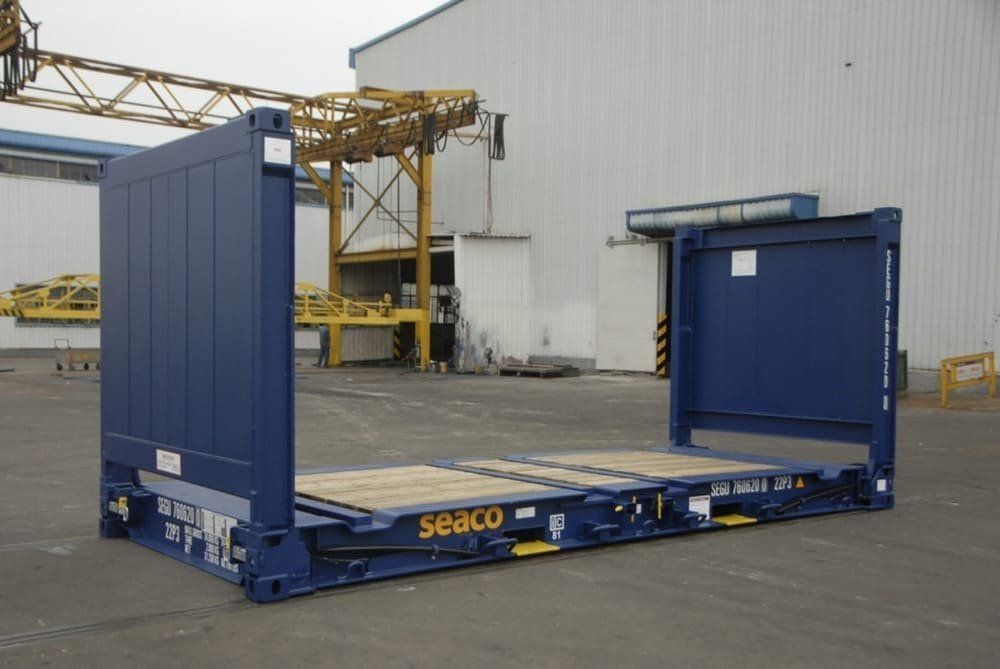
Positioning: Open sides/top with fixed or collapsible end-walls; built for heavy, out-of-gauge (OOG) pieces.
Typical capacity (varies):
- 20FR often rated around 30 t payload; 40FR commonly around 40 t—confirm per series. Lashing eyes are designed for high SWL.
Best for:
- Pipes, vehicles, machinery, construction equipment
Not for:
- Fine or weather-sensitive cargo without additional protection
China-to-West execution tip:
- Draft a lashing plan and balance loads over the bottom rails. Pre-book terminal handling and confirm OOG surcharges and lift windows.
Evidence: The Maersk Lashing Guide provides principles for securing and weight distribution for special cargo and OOG moves (Maersk — Lashing Guide, PDF, accessed 2025).
Temperature control
9) Reefer (20’ / 40’ / 40HC)

Positioning: Actively temperature-controlled; internal volume is reduced by insulation and machinery.
Typical operating ranges and notes (varies):
- Approx. -30°C to +30°C for standard reefers; “super freezer” units can reach around -60°C. Controlled-atmosphere tech supports certain produce.
Best for:
- Food, pharmaceuticals, and other perishables; any load needing validated temperature logging end-to-end
Not for:
- Non-temperature-sensitive cargo—reefers cost more and yield less usable volume
China-to-West execution tip:
- Book PTI (pre-trip inspection) and confirm power availability during dray/transit. Align your cold-chain documents and sensor logging with consignee QA.
Evidence: Temperature capabilities and equipment options are summarized in the 2025 reefer brochure from Ocean Network Express (ONE — Reefer Brochure 2025).
Liquids in bulk
10) ISO Tank (20’ frame)
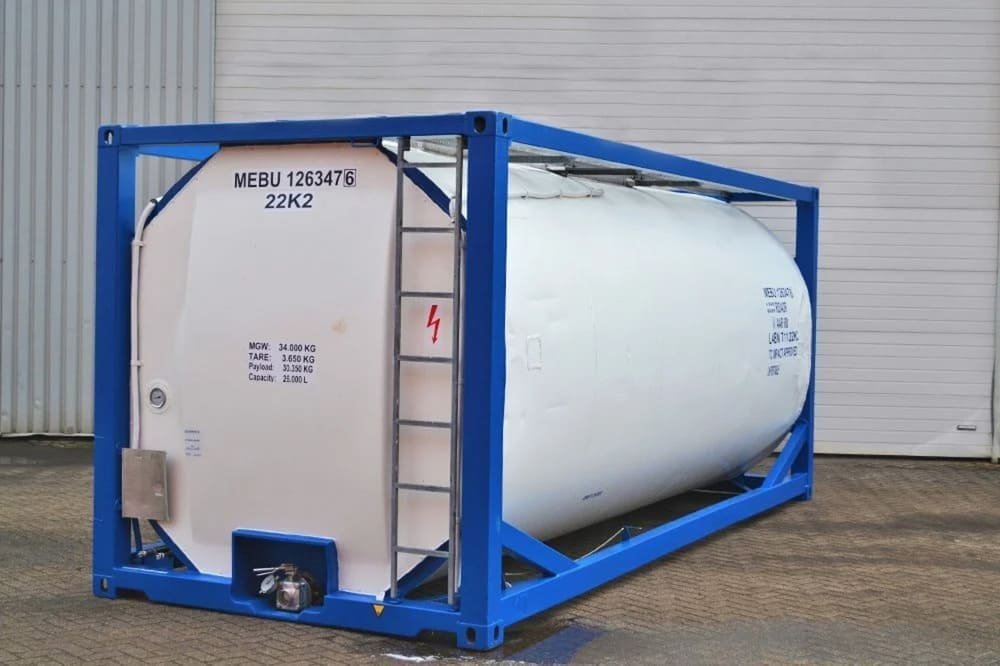
Positioning: The efficient way to move bulk liquids (food-grade and chemical), including many hazardous classes.
Typical specs (varies):
- Common capacities include ~21,000–26,000 liters; max gross depends on tank type (e.g., T11). Regulated under IMDG/UN portable tank codes.
Best for:
- Chemicals, food oils, solvents—where drum/IBC handling would be inefficient or unsafe
Not for:
- Solid goods or tiny liquid volumes—use IBCs/drums instead
China-to-West execution tip:
- Verify the correct tank designation, fill ratio, and cleaning/testing certificates. Hazardous documentation must be pre-approved before gate-in.
Evidence: Regulatory framework and shipper obligations are outlined by the International Maritime Organization’s dangerous goods resources (IMO — Dangerous goods, accessed 2025).
Regional optimization
11) Pallet Wide (PW)

Positioning: Wider internal width to fit two Euro pallets side-by-side; prevalent on Europe-bound lanes and intra-Europe logistics.
Typical spec note (varies):
- Internal width roughly ~2.42 m, enabling two EUR pallets across; available in 40HC PW variants among leasing/carrier fleets.
Best for:
- Europe-bound FMCG and e-commerce optimizing EUR pallets from China to EU destinations
Not for:
- Lanes where PW equipment isn’t commonly accepted or available
China-to-West execution tip:
- Specify “PW” on the booking and confirm depot availability at origin. PW can reduce wasted space on EUR pallets and improve stability in transit.
Evidence: Leasing fleets detail PW HC variants and their intended use on Euro lanes (e.g., Triton — 45ft Pallet-Wide High Cube Containers, accessed 2025).
Airflow for specific commodities
12) Ventilated (passive airflow)

Positioning: Built-in passive vents manage humidity and allow airflow—traditional for commodities like coffee or cocoa.
Typical spec note (varies):
- Internal dimensions generally mirror standard sizes; the key difference is the venting system.
Best for:
- Agricultural commodities that benefit from airflow and moisture reduction
Not for:
- Goods requiring active temperature control or hermetic seals
China-to-West execution tip:
- Pair with desiccants in humid seasons and plan stuffing to allow airflow channels.
Evidence: Ventilated and other special types are categorized within carrier fleets (see Hapag-Lloyd — Container type groups, accessed 2025).
China-to-West execution essentials (don’t skip these)
- CY vs CFS cut-offs: FCL (CY) gate-in deadlines are often just a couple of days before sailing, while LCL (CFS) cut-offs are typically earlier to allow consolidation. Plan your documentation and pick/pack timelines accordingly.
- SOLAS VGM: You must submit a Verified Gross Mass before loading, either by weighing the packed container (Method 1) or by calculation (Method 2). Carriers may require VGM 24–72 hours before the cutoff to ensure “load list” eligibility.
- Amazon FBA (US) pallet/box rules: As of 2025, common constraints include 40×48 in pallets, typical max pallet height 72 in (or 100 in if double-stacked), and a max box length of 36 in with max weight 50 lb unless a single oversize item. Make container choice and pallet plans with these caps in mind.
Citations for the above:
- VGM background and shipper obligations summarized by Maersk’s guide (published 2023) and the SOLAS amendments administered by IMO (Maersk — VGM explainer; IMO — Dangerous goods).
- Amazon FBA routing and pallet/box requirements are documented in Seller Central (accessed 2025): Amazon — Shipping and routing requirements.
Common factory loading errors we see in China (and how to prevent them)
- Misdeclared gross/tare leading to VGM mismatches → Require weigh tickets and agent verification before VGM submission.
- Uneven weight distribution (back-heavy) → Provide a simple load map and require photos after the first two pallet placements.
- Over-height pallets in non-HC containers → Pre-approve carton sizes and pallet build heights; verify door aperture, not just internal ceiling.
- Missed CY cut-off due to last-minute labeling or missing docs → Lock internal deadlines 24–48 hours ahead; use a checklist for commercial invoice, packing list, and labels.
When should an FBA apparel brand move from LCL to a 40HC?
- Shipment frequency: If you’re booking two or more LCLs per month, the operational overhead and risk (CFS handling, longer lead time) may outweigh the cost of one 40HC.
- Carton density and seasonality: Apparel is light. A 40HC’s extra height lets you stack more per pallet without crushing, reducing sailings.
- Compliance headroom: With 40HC, you’ll more easily plan pallet heights that respect both FBA caps and door clearance.
If your replenishments are approaching the above thresholds, model a 40HC FCL plan alongside your next LCL quote and compare total landed cost plus cycle time.
Next steps
- Map your SKU mix and seasonality to one of the 12 types above; validate dimensions and pallet builds against the actual equipment series you’ll receive.
- Align your factory, forwarder, and destination warehouse on cut-offs, VGM workflow, and labeling to avoid roll-overs and rework.
- If you’re launching or scaling an FBA apparel program out of China, consider piloting a 40HC plan for your next campaign and monitor cycle time and damage rates.
Ready to get specific? Start your China Sourcing & Shipping Plan and we’ll help you choose equipment, design pallet builds, schedule around cut-offs, and supervise loading end-to-end.
